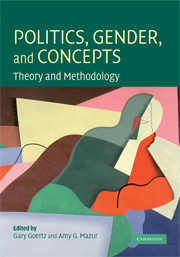Book contents
- Frontmatter
- Contents
- List of figures
- List of tables
- Notes on contributors
- Acknowledgments
- 1 Introduction
- 2 Mapping gender and politics concepts: ten guidelines
- Part I Gendering Concepts
- 3 Gendering democracy
- 4 Gendering representation
- 5 Gendering the welfare state
- 6 Gendering governance
- 7 Gendering development
- Part II Gender-Specific Concepts
- Appendix: A website for additional gender and politics concepts
- References
- Index
4 - Gendering representation
Published online by Cambridge University Press: 06 July 2010
- Frontmatter
- Contents
- List of figures
- List of tables
- Notes on contributors
- Acknowledgments
- 1 Introduction
- 2 Mapping gender and politics concepts: ten guidelines
- Part I Gendering Concepts
- 3 Gendering democracy
- 4 Gendering representation
- 5 Gendering the welfare state
- 6 Gendering governance
- 7 Gendering development
- Part II Gender-Specific Concepts
- Appendix: A website for additional gender and politics concepts
- References
- Index
Summary
The first part of this book clearly illustrates one of the fundamental contributions of feminist and women's studies: revealing the gender bias of so-called objective and neutral concepts (Squires 1999, Bryson 2003). Representation was fated to undergo the same treatment. The gendered dimension of representation is evident regarding the actors; because the represented and the representatives by definition have a sex and a gender, representation is not immune to being structured by hierarchical relations between men and women. However, “gendering representation” is not only concerned with the sex of the bodies, but also focuses on the “what” of representation and examines representatives' acts and claims using a gendered lens (see also Mazur and McBride in this volume). Besides taking into account the sex of the actors involved and the gendered character of representation, “gendering representation” fundamentally questions the way this concept is conceived and formulates conditions for “good” – that is, truly representative – representation (Dovi 2007) and even for democracy as such (see Paxton in this volume). A key contribution of feminist scholars is the rejection of a clear-cut separation of the dimensions of representation, as well as of the hierarchy between them. According to theorists of group representation, descriptive and substantive representation are intertwined, as the former is a prerequisite for the latter. Thereby, feminist analysis of representation complements mainstream political debates revolving around the questions “What is to be represented?” and “What is the relationship between the representative and the represented?”
- Type
- Chapter
- Information
- Politics, Gender, and ConceptsTheory and Methodology, pp. 71 - 93Publisher: Cambridge University PressPrint publication year: 2008
- 20
- Cited by

